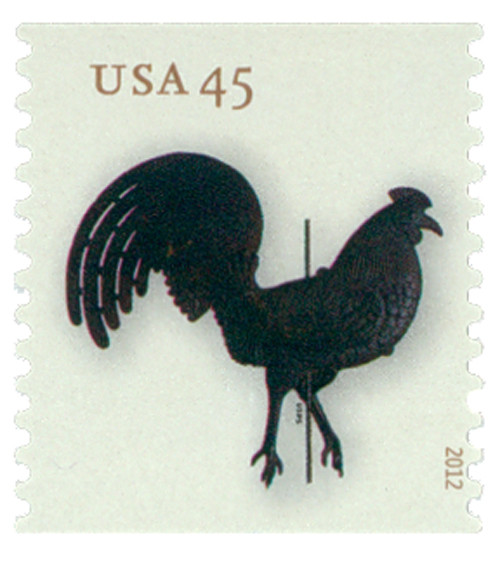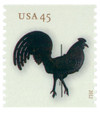
# 4616 - 2012 45c Weathervanes: Rooster without Perch
U.S. #4616
2012 45¢ Rooster without Perch
Weather Vanes
Issue Date: January 20, 2012
City: Shelburne, VT
Quantity: 60,000,000
Printed By: Banknote Corporation of America for Sennett Security Products
Printing Method: Offset
Color: Multicolored
Weathervanes have been a practical accessory for homes and villages since the United States was settled. But throughout the years they have evolved into a form of art with a distinctly American flair. From Colonial times to the present, weathervanes have become a means of personal expression, as well as a handy tool.
The concept behind a weathervane is simple – balance an object on a pole so that its weight is evenly distributed, but one side has a larger surface area (and preferably is flat) to catch the wind. The wind will then push the object so that the smaller end points in the direction the wind is coming from. Since shifting winds can indicate a change in weather, this has always been critically important to farmers and sailors.
Most early Colonial weathervanes were made from wood, with few lasting through the centuries. More durable versions were made from metals such as tin or copper. Creative artisans gave them more and more elaborate shapes. Roosters, hunting dogs, running horses, and ships are just some of the countless themes. These often emerge as valuable heirlooms. A mid-19th century bronze horse and rider fetched $700,000 in a 1990 auction.
Yet, while their art value has soared, classic Colonial weathervanes remain most cherished as symbols of our American heritage.
U.S. #4616
2012 45¢ Rooster without Perch
Weather Vanes
Issue Date: January 20, 2012
City: Shelburne, VT
Quantity: 60,000,000
Printed By: Banknote Corporation of America for Sennett Security Products
Printing Method: Offset
Color: Multicolored
Weathervanes have been a practical accessory for homes and villages since the United States was settled. But throughout the years they have evolved into a form of art with a distinctly American flair. From Colonial times to the present, weathervanes have become a means of personal expression, as well as a handy tool.
The concept behind a weathervane is simple – balance an object on a pole so that its weight is evenly distributed, but one side has a larger surface area (and preferably is flat) to catch the wind. The wind will then push the object so that the smaller end points in the direction the wind is coming from. Since shifting winds can indicate a change in weather, this has always been critically important to farmers and sailors.
Most early Colonial weathervanes were made from wood, with few lasting through the centuries. More durable versions were made from metals such as tin or copper. Creative artisans gave them more and more elaborate shapes. Roosters, hunting dogs, running horses, and ships are just some of the countless themes. These often emerge as valuable heirlooms. A mid-19th century bronze horse and rider fetched $700,000 in a 1990 auction.
Yet, while their art value has soared, classic Colonial weathervanes remain most cherished as symbols of our American heritage.









